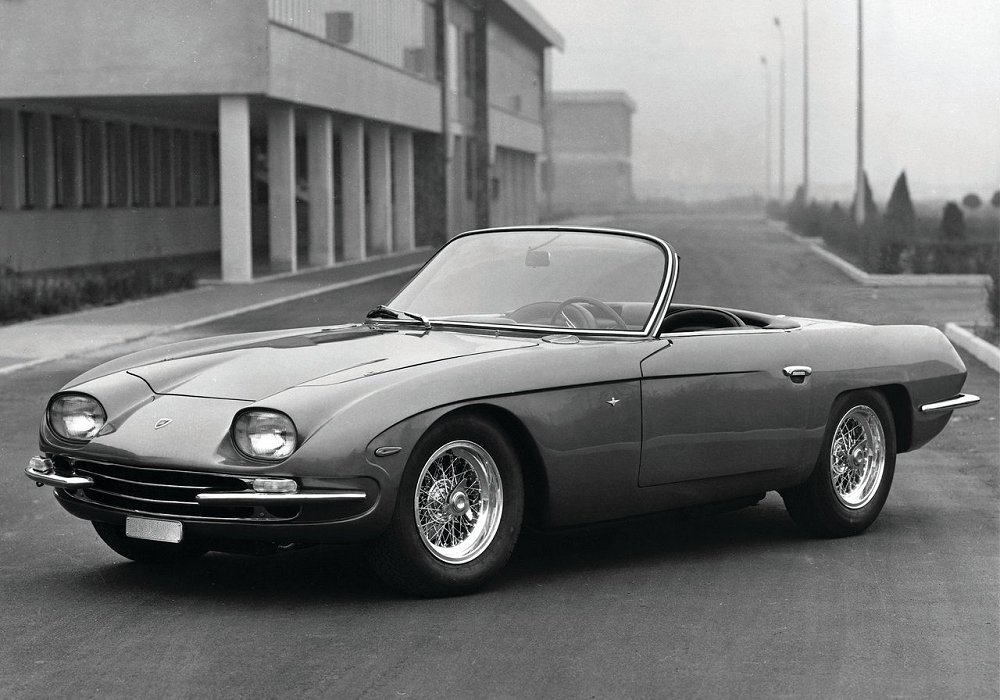Description
The Lamborghini 350 GTS Spider was one of the rarest and most captivating expressions of Lamborghini’s early grand touring philosophy—a beautiful open-top evolution of the 350 GT that combined Bizzarrini’s magnificent V12 engine with the grace of an Italian handcrafted roadster. Built as a limited, coachbuilt prototype in 1965 by Carrozzeria Touring of Milan, the 350 GTS embodied the sophistication, performance, and artistry that defined Lamborghini’s formative years. Only two examples were ever produced, making it one of the most exclusive Lamborghinis ever built and a jewel of Italian automotive craftsmanship.
When Ferruccio Lamborghini founded Automobili Lamborghini in 1963, his ambition was not to build racing cars but refined high-speed grand tourers—machines that would rival Ferrari in performance but surpass them in comfort and drivability. The company’s first production model, the 350 GT, achieved exactly that. Elegant, mechanically sophisticated, and effortlessly fast, it immediately established Lamborghini as a serious manufacturer of luxury performance automobiles. The 350 GTS was conceived as an open-top version of that car—a grand touring spider that could combine the 350 GT’s refinement with the romance of open-air motoring.
The project was entrusted to Carrozzeria Touring, the Milanese coachbuilder responsible for the 350 GT’s exquisite aluminium bodywork. Touring’s patented “Superleggera” construction method—light alloy panels over a framework of small steel tubes—allowed the creation of a convertible body that retained rigidity and balance while keeping the weight low. The result was a design of remarkable purity: sleek, flowing, and perfectly proportioned.
The 350 GTS retained the mechanical foundation of the 350 GT, built around a steel tubular chassis designed by Gian Paolo Dallara and powered by Giotto Bizzarrini’s masterpiece—a 3.5-litre (3464 cc) aluminium V12 engine. Featuring four overhead camshafts, six twin-choke Weber carburetors, and dry-sump lubrication, the engine produced approximately 320 horsepower at 7,000 rpm. Power was delivered to the rear wheels through a five-speed ZF gearbox and a Salisbury limited-slip differential. With its low kerb weight and high-revving engine, the 350 GTS was capable of speeds exceeding 150 mph (240 km/h), placing it among the fastest convertibles in the world at the time.
The 350 GTS’s chassis was tuned for comfort and precision, featuring fully independent suspension on all four wheels—double wishbones with coil springs and telescopic dampers—and Girling disc brakes all around. The car’s balance and ride quality were exceptional, offering the poise of a thoroughbred sports car with the smoothness of a luxury touring machine. The steering was light yet communicative, and the car’s nimble handling and supple suspension made it ideally suited for high-speed European travel.
Visually, the 350 GTS was stunning. Touring’s design evolved the lines of the 350 GT into a more sensual, open form. The long bonnet, subtly flared wheel arches, and gently rising waistline gave the car a natural sense of motion, while the low, sweeping roofline of the coupé was replaced with a clean convertible profile. With the top lowered, the 350 GTS revealed its perfectly proportioned cockpit and the elegant curvature of its rear deck, which concealed the folding roof beneath a flush-fitting metal cover. Chrome accents traced the grille, bumpers, and window frames, adding a touch of sophistication without overwhelming the purity of the shape. The overall aesthetic was refined and graceful—more understated than its Ferrari contemporaries, yet every bit as captivating.
Inside, the 350 GTS shared the same level of craftsmanship as the coupé. The cockpit was trimmed in hand-stitched leather, with a wood-rimmed Nardi steering wheel, polished aluminium dashboard trim, and a full suite of Jaeger instruments. The seats were designed for comfort during long journeys, while the cabin layout maintained the clean, functional simplicity that characterized all early Lamborghinis. The windscreen was low and elegantly curved, enhancing the open-air experience while preserving aerodynamic efficiency.
Driving the 350 GTS was an experience of refined exhilaration. The V12 engine delivered its power in a smooth, linear surge, its sound building from a silky murmur to a rich, metallic wail as the revs climbed. The car’s light weight and well-balanced chassis made it agile and responsive, yet it was never harsh or demanding. It felt composed at speed, effortlessly covering ground with a sense of grace that few open sports cars of its time could match. The combination of engineering precision and emotional appeal made it one of the most rewarding grand tourers ever conceived.
Despite its brilliance, the 350 GTS remained a prototype. Only two cars were built by Touring in 1965, both finished to the highest standards and used by Lamborghini for display and testing purposes. The cost of producing such a complex, hand-built convertible body proved prohibitive, and the focus soon shifted to developing the larger and more powerful 400 GT series. The idea of an open-top Lamborghini would not return until the 1966 Miura Roadster prototype and later the production Espada and Jarama models.
Today, both 350 GTS examples survive and are among the most valuable Lamborghinis in existence. Their rarity, historical significance, and timeless beauty make them centerpieces of the marque’s early history. Each represents a glimpse of Lamborghini’s purest ideals—technical perfection, aesthetic restraint, and the joy of driving distilled into its most elegant form.
The Lamborghini 350 GTS Spider remains a symbol of the company’s youthful ambition and creative daring. It was not designed for mass production but as a demonstration of what Lamborghini could achieve at its best: a grand tourer of sublime engineering and poetic beauty. In its flowing lines and glorious V12 symphony, it captured the essence of the 1960s Italian dream—a vision of speed, grace, and unrestrained freedom under the open sky.

